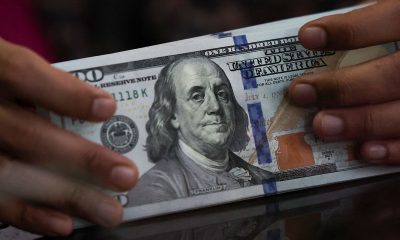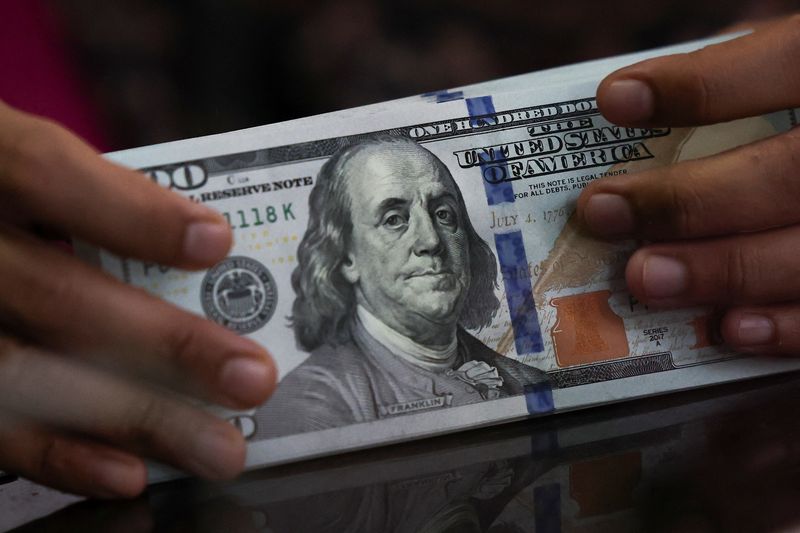Forex
Explainer-What would Japanese intervention to boost a weak yen look like?

By Leika Kihara
TOKYO (Reuters) -Japanese authorities are facing renewed pressure to combat a sustained depreciation in the yen, as traders drive down the currency on expectations that any further interest rate hikes by the central bank will be slow in forthcoming.
Below are details on how yen-buying intervention works:
LAST CONFIRMED YEN-BUYING INTERVENTION?
Japan bought yen in September 2022, its first foray in the market to boost its currency since 1998, after a Bank of Japan (BOJ) decision to maintain its ultra-loose monetary policy drove the yen as low as 145 per dollar. It intervened again in October after the yen plunged to a 32-year low of 151.94.
WHY STEP IN?
Yen-buying intervention is rare. Far more often the Ministry of Finance has sold yen to prevent its rise from hurting the export-reliant economy by making Japanese goods less competitive overseas.
But yen weakness is now seen as problematic, with Japanese firms having shifted production overseas and the economy heavily reliant on imports for goods ranging from fuel and raw materials to machinery parts.
WHAT HAPPENS FIRST?
When Japanese authorities escalate their verbal warnings to say they “stand ready to act decisively” against speculative moves, that is a sign intervention may be imminent.
Rate checking by the BOJ – when central bank officials call dealers and ask for buying or selling rates for the yen – is seen by traders as a possible precursor to intervention.
WHAT HAPPENED SO FAR?
Finance Minister Shunichi Suzuki told reporters on March 27 that authorities could take “decisive steps” against yen weakness – language he hasn’t used since the 2022 intervention.
remove ads
.
Hours later, Japanese authorities held an emergency meeting to discuss the weak yen. The meeting is usually held as a symbolic gesture to markets that authorities are concerned about rapid currency moves.
After the warnings failed to arrest the yen’s fall, South Korea and Japan won acknowledgement from the United States over their “serious concerns” about their currencies’ declines in a trilateral meeting held in Washington last week.
The market impact of the agreement did not last long. The dollar continued its ascent and notched a 34-year high of 155.74 yen on Thursday, driving past the 155 level seen as authorities’ line in the sand for intervention.
NEXT LINE IN THE SAND?
Authorities say they look at the speed of yen falls, rather than levels, and whether the moves are driven by speculators, to determine whether to step into the currency market.
While the dollar has moved above the psychologically important 155 level, the recent rise has been gradual and driven mostly by U.S.-Japanese interest rate differentials. That may make it hard for Japan to argue that recent yen falls are out of line with fundamentals and warrant intervention.
Some market players bet Japanese authorities’ next line in the sand could be 160. Ruling party executive Takao Ochi told Reuters the yen’s slide towards 160 or 170 to the dollar could prod policymakers to act.
WHAT’S THE TRIGGER?
The decision is highly political. When public anger over the weak yen and a subsequent rise in the cost of living is high, that puts pressure on the administration to respond. This was the case when Tokyo intervened in 2022.
remove ads
.
Prime Minister Fumio Kishida may feel the need to prevent further yen falls from pushing up the cost of living with his approval ratings faltering ahead of a ruling party leadership race in September.
But the decision would not be easy. Intervention is costly and could easily fail, given that even a large burst of yen buying would pale next to the $7.5 trillion that change hands daily in the foreign exchange market.
HOW WOULD IT WORK?
When Japan intervenes to stem yen rises, the Ministry of Finance issues short-term bills, raising yen it then sells to weaken the Japanese currency.
To support the yen, however, the authorities must tap Japan’s foreign reserves for dollars to sell for yen.
In either case, the finance minister issues the order to intervene and the BOJ executes the order as the ministry’s agent.
CHALLENGES?
Japanese authorities consider it important to seek the support of Group of Seven partners, notably the United States if the intervention involves the dollar.
Washington gave tacit approval when Japan intervened in 2022, reflecting recent close bilateral relations.
Finance Minister Suzuki said last week’s meeting with his U.S. and South Korean counterparts laid the groundwork to act against excessive yen moves, a sign Tokyo saw the meeting as informal consent by Washington to intervene as needed.
U.S. Treasury Secretary Janet Yellen said currency interventions should occur only in “very rare and exceptional circumstances,” when markets are disorderly with excessive volatility. She declined to comment on the yen’s value.
A looming U.S. presidential election may complicate Japan’s decision on whether and when to intervene.
remove ads
.
In a social media post on Tuesday, Republican presidential candidate Donald Trump decried the yen’s historic slide against the dollar, calling it a “total disaster” for the United States.
There is no guarantee intervention will effectively shift the weak-yen tide, which is driven largely by expectations of prolonged low interest rates in Japan. BOJ Governor Kazuo Ueda has dropped hints of another rate hike but stressed that the bank will tread cautiously given Japan’s fragile economy.

 Forex3 years ago
Forex3 years agoForex Today: the dollar is gaining strength amid gloomy sentiment at the start of the Fed’s week

 Forex3 years ago
Forex3 years agoUnbiased review of Pocket Option broker

 Forex3 years ago
Forex3 years agoDollar to pound sterling exchange rate today: Pound plummeted to its lowest since 1985

 Forex3 years ago
Forex3 years agoHow is the Australian dollar doing today?

 Cryptocurrency3 years ago
Cryptocurrency3 years agoWhat happened in the crypto market – current events today

 World3 years ago
World3 years agoWhy are modern video games an art form?

 Commodities3 years ago
Commodities3 years agoCopper continues to fall in price on expectations of lower demand in China

 Economy3 years ago
Economy3 years agoCrude oil tankers double in price due to EU anti-Russian sanctions





























